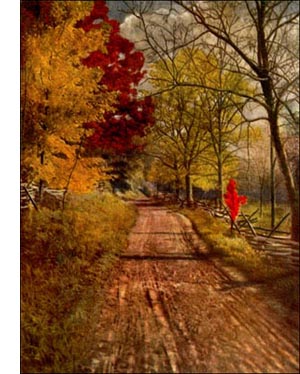Box Elder or Ash Leaved Maple Tree
 Box Elder, Ash-leaved Maple (Acer Negundo, Linn.)A quick-growing, sturdy tree, 50 to 70 feet high, with irregular spreading top. Bark greyish, regularly furrowed; twigs purple, glaucous. Wood soft, white, weak, close grained.
Box Elder, Ash-leaved Maple (Acer Negundo, Linn.)A quick-growing, sturdy tree, 50 to 70 feet high, with irregular spreading top. Bark greyish, regularly furrowed; twigs purple, glaucous. Wood soft, white, weak, close grained. Buds opposite, blunt, reddish. Leaves opposite, compound, of 3 to 5 pinnate leaflets, irregularly toothed and lobed; smooth, pale beneath; yellow in autumn. Flowers open with leaves on separate trees, fertile, greenish, in drooping racemes, sterile, in clusters on pink, silky pedicels.
Fruits narrow, flat, winged samaras, 1 1/2 to 2 inches long, in pairs, clustered in drooping racemes; ripe in September, but hanging until early spring. Preferred habitat, rich, moist soil, by streams or along borders of swamps.
Distribution, Vermont to Montana; south to Florida and west to Colorado and Utah. Rare east of Appalachian Mountains. Uses: Much planted for shade and ornament. Wood inferior; used for cooperage and small woodenwares.
There are two things remarkable about the box elder: its geographical range, natural and acquired, and the variation of altitudes it will endure with cheerfulness. Out of a certain number of nursery trees you may plant a row rising gradually from low bottom land to an altitude of 6,000 feet above sea level, and they will all thrive.
It is the nature of mankind to love box elders for growing where most trees refuse. In the treeless regions people had no time to experiment with uncertain trees. Their land, taken up under the homestead laws, had to show so many acres of woodland at the end of a certain time. So box elders and cottonwoods and soft maples went in, because they could best be depended upon to grow. The windbreak behind the settler's house and the shade trees in front were of these same trees. They grew, but they didn't do well.
In the Middle West the quick growth and youthful prettiness of the box elder have led people to keep on planting it, though the early day of planting for shelter belts and windbreaks is past. The result is that in many a village the majority of its trees are unsightly, broken-down box elders and willows, with a few fine elms, hard maples and ashes to redeem it. It is high time the habit of planting the inferior, temporary kinds of trees was overcome.
In the interests of village improvement and the fostering of a love for better trees I went out to reason with a neighbour who had come over to beg a few trees to plant in front of his new house. He was digging a volunteer box elder out of our blackberry patch, when I expostulated, offering him some handsome young elms instead. 'Twas throwing words away. " I told yo' paw I'd ruther have box elders, an' he said I could." "But why wouldn't you rather have the elms? You can see yourself that the finest trees in town are elms."
"Yes, they're harnsome trees-elms is; but it's the shade I want. I always noticed that box elders, big or little, has the coolest shade of any trees they is." Before such subtle distinctions I was dumb.